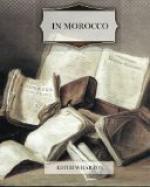The European town of Rabat, a rapidly developing community, lies almost wholly outside the walls of the old Arab city. The latter, founded in the twelfth century by the great Almohad conqueror of Spain, Yacoub-el-Mansour, stretches its mighty walls to the river’s mouth. Thence they climb the cliff to enclose the Kasbah[A] of the Oudayas, a troublesome tribe whom one of the Almohad Sultans, mistrusting their good faith, packed up one day, flocks, tents and camels, and carried across the bled to stow them into these stout walls under his imperial eye. Great crenellated ramparts, cyclopean, superb, follow the curve of the cliff. On the landward side they are interrupted by a gate-tower resting on one of the most nobly decorated of the horseshoe arches that break the mighty walls of Moroccan cities. Underneath the tower the vaulted entrance turns, Arab fashion, at right angles, profiling its red arch against darkness and mystery. This bending of passages, so characteristic a device of the Moroccan builder, is like an architectural expression of the tortuous secret soul of the land.
[Footnote A: Citadel.]
[Illustration: From a photograph from the Service des Beaux-Arts au Maroc
Rabat—general view from the Kasbah of the Oudayas]
Outside the Kasbah a narrow foot-path is squeezed between the walls and the edge of the cliff. Toward sunset it looks down on a strange scene. To the south of the citadel the cliff descends to a long dune sloping to a sand-beach; and dune and beach are covered with the slanting headstones of the immense Arab cemetery of El Alou. Acres and acres of graves fall away from the red ramparts to the grey sea; and breakers rolling straight from America send their spray across the lowest stones.
There are always things going on toward evening in an Arab cemetery. In this one, travellers from the bled are camping in one corner, donkeys grazing (on heaven knows what), a camel dozing under its pack; in another, about a new-made grave, there are ritual movements of muffled figures and wailings of a funeral hymn half drowned by the waves. Near us, on a fallen headstone, a man with a thoughtful face sits chatting with two friends and hugging to his breast a tiny boy who looks like a grasshopper in his green caftan; a little way off, a solitary philosopher, his eye fixed on the sunset, lies on another grave, smoking his long pipe of kif.
There is infinite sadness in this scene under the fading sky, beside the cold welter of the Atlantic. One seems to be not in Africa itself, but in the Africa that northern crusaders may have dreamed of in snow-bound castles by colder shores of the same ocean. This is what Moghreb must have looked like to the confused imagination of the Middle Ages, to Norman knights burning to ransom the Holy Places, or Hansa merchants devising, in steep-roofed towns, of Barbary and the long caravans bringing apes and gold-powder from the south.




